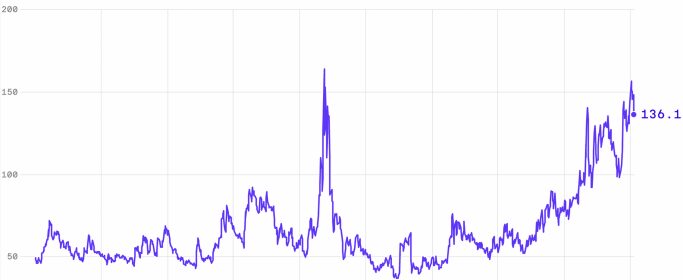Corporate debt suffers "indigestion" as uncertainty roils market

The investment grade (IG) corporate bond market usually gives off safe and boring vibes. This year, not so much.
Why it matters: The trillions-deep IG market is where the biggest and most credit-worthy U.S. companies borrow money. But just like in the mortgage market, where extreme rate volatility is wreaking havoc on both borrowers and lenders, things have gotten chaotic under the hood of the IG market, too.
- Average total returns on IG bonds (also known as high grade) were negative 14% over the first half of the year, one of their biggest losses in history, according to a BofA research note.
- New issuance in this market plunged in Q2 by 42% compared to Q1, and by 27% from the second quarter of last year, according to Leveraged Commentary & Data (LCD).
- There were at least two weeks with zero or near zero issuance over the last couple months. "That's unusual," says Yuri Seliger, credit strategist at BofA.
State of play: Generally, as benchmark Treasuries go, so do yields on high grade corporates.
- ICE Data Services' MOVE Index, which tracks Treasury volatility sort of like a VIX for the bond market, has shot up this year to levels nearing their early pandemic highs (see the chart above).
So for investors who need to trade high grade bonds, it's gotten a lot more difficult out there.
- Bid/ask spreads — the gap between buyer and seller price demands — have widened dramatically.
- Crucially, the dealers that usually step in to bridge that gap — by committing capital to holding some of the bonds temporarily — aren't willing to hold nearly as much inventory as they used to. That's exacerbating price swings, Matt Brill, head of North America investment grade for Invesco Fixed Income, tells Axios.
What they're saying: Dealers "are finding it very hard to source the paper that their clients want to buy," says Josh Lohmeier, investment grade portfolio manager at Franklin Templeton.
- "And they're simultaneously finding it very hard to find a home for the bonds that their clients want to sell. The indigestion of not being able to get anything done is very hard right now," he says.
Dealer inventories of IG bonds were just $2.1 billion as of June 29, significantly lower than most of the last nine years (they were as high as the $10 billion area late last year), according to a BofA analysis of Federal Reserve data.
- The reduction stems from post-financial crisis regulatory capital changes for banks that have been phased in over time — and are now colliding with the market selloff, says Tony Roth, chief investment officer at Wilmington Trust.
Meanwhile, for companies that want to tap the market for funding, the problem isn't just a higher cost of capital compared to, say, six months ago.
- The volatility also means that if they want to bring a deal to market on any given day, their bankers may or may not be able to sell it as planned — and it's not a great look if a deal fizzles out.
- Case in point: Tech giant Oracle has long been expected to tap the bond market to fund its acquisition of Cerner — but its bankers still haven't actually pulled the trigger. The acquisition has already closed, relying on short-term bridge financing for now.
The bottom line: So far these hang-ups have been largely rates-driven. They'll only get worse if the economy heads into recession and actual credit quality starts to deteriorate.
Source: Read Full Article

